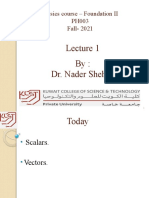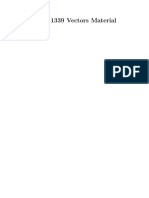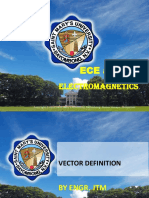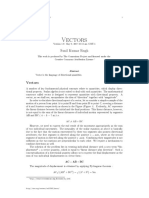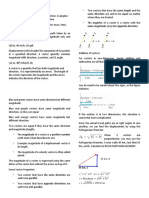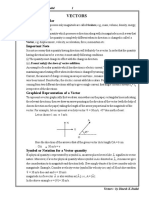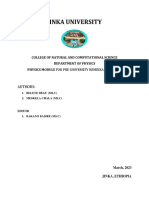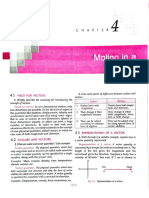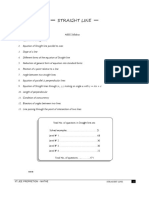2024 S4 EM Vectors Notes (With Annotations)
Uploaded by
Fan Hong2024 S4 EM Vectors Notes (With Annotations)
Uploaded by
Fan HongSCHOOL OF SCIENCE AND TECHNOLOGY, SINGAPORE
MATHEMATICS DEPARTMENT 2024
SECONDARY 4
Name: ( ) Class: S4 –___
VECTORS IN TWO DIMENSIONS
Subject Content from Syllabus Document MATHEMATICS 4052
Topic/Sub-topics Content
"
G7 Vectors in two • Use of notations: !#$, '''''⃗
%&, a, )%&'''''⃗ ) and |+|
dimensions • Representing a vector as a directed line segment
• Translation by a vector
"
• Magnitude of a vector !#$ as ," ! + # !
• Use of sum and differences of two vectors to express given
vectors in terms of two coplanar vectors
• Multiplication of a vector by a scalar
• Geometric problems involving the use of vectors
Learning Objectives
At the end of the unit, students should be able to
• Represent a vector and its magnitude using various notations.
• Use the sum and difference of two vectors to express given vectors in terms of 2
coplanar vectors
• Perform vector addition, subtraction and scalar multiplication.
• Represent a vector on the Cartesian coordinate plane using column vector notation
• Find the magnitude and direction of a column vector.
• Perform translation using a vector.
• Use vectors to show that 3 points on the Cartesian plane are collinear
• Prove that two vectors are parallel.
• Use vectors to solve geometric problems and apply in different contexts.
ENDURING UNDERSTANDING
• Vectors involve directions and magnitudes.
• Magnitudes and directions provide spatial relationships in two dimensions.
• Vectors model and solve mathematical and real-life problems involving forces
• Vectors determine the representation of the resultant force or resultant motion
when 2 forces are applied on a body.
EM Vectors Page 1
ESSENTIAL QUESTIONS
• How are vectors and scalars similar and different?
• How can vector operations be used to model, solve and interpret real-world problems?
• How can addition, subtraction and scalar multiplication of vectors be
represented/notated geometrically?
• What are some different ways to add two vectors and how are these
representations/notations related?
RESOURCES
• think! Mathematics - New Syllabus Mathematics 4 (8th ed), Shinglee.
NOTATION USED IN THIS CHAPTER
• Representation of a vector using direct line segments and vector notation.
• Representation of position vectors using the coordinate system.
Self-Checklist (to be done at the end of the unit)
I can do I can
I need
Level Knowledge & Skills help!
on my explain to
own others
Represent a vector and its magnitude using various
0
notations
Use the sum and difference of two vectors to express given
1
vectors in terms of 2 coplanar vectors
Perform vector addition, subtraction and scalar
1
multiplication
Represent a vector on the Cartesian coordinate plane using
1
column vector notation
1 Find the magnitude and direction of a column vector
2 Perform translation using a vector
Use vectors to show that 3 points on the Cartesian plane are
2
collinear
2 Prove that two vectors are parallel
Use vectors to solve geometric problems and apply in
3
different contexts
EM Vectors Page 2
Section 1 - Scalar and Vector Quantities
Activity 1 – Think-Pair-Share – Will John and Jane meet?
John walks 30 metres from P.
Jane walks 30 metres on a bearing of 045° from point P.
Determine the final location of both John and Jane from point P in the space below using a
scale of 1 cm to 10 m.
• P
Discussion Questions
• As both John and Jane walk the same distance from P, will both John and Jane end up
in the same final position? Explain your answer.
• Is distance is not enough to describe motion. What else do you need?
EM Vectors Page 3
We use numerical measurements in our daily life.
It is important for us to be able to distinguish between the measurements in scalar and vector
quantities.
Scalar Quantities Vector Quantities.
• A scalar is a quantity that has magnitude • A vector is a quantity that has both
(size) but no direction. magnitude (size) and direction.
• Example: mass of objects are measured • Example, when we pull on a door handle,
using kilograms. we exert a force. The force we exert has
• Scalar quantities do not necessarily need both magnitude (hard or gentle pull) and
to be positive always. Negative signs in direction (opening or closing a door).
scalar quantity also exists.
• Example temperature in Celsius exists in
both positive and negative quantities.
From Activity 1, the distance, of 50 m, From Activity 1, the displacement of 50 m
travelled by John is a scalar. (magnitude) of Jane on a bearing of 045°
(also known as direction) is a vector.
Activity 2 – Scalar or Vector?
The following situations need to be described using an appropriate measure.
Classify the measure as a scalar of vector using a tick in the respective column.
Quantities Scalar Vector
1 The time taken to complete running 2.4 km.
2 The weight of durians in a basket.
3 The amount of liquid in a jug.
4 The force exerted on an object.
5 A classroom desk that has been moved from the front of the room
to the back.
6 The balance in a bank account.
7 The electric current passing through an electric light tube.
8 An aircraft starts its takeoff run.
9 The wind conditions before a yacht race.
10 The length of a car.
11 The velocity of a race car at 180 km/h.
12 The magnetic field of earther at a given place.
EM Vectors Page 4
Section 2 - Representation of Vectors
Big IDEA: Notation
Vector Notation
A vector can be represented by a directed line segment, where the direction of the line segment
is that of the vector, and the length of the line segment represents the magnitude of the vector.
N
B
75° 8 km AB
A
The displacement vector is denoted by '''''⃗
%&, where A is the starting or initial point and B is the
® ®
ending or terminal point. The magnitude of AB is denoted by | AB | . In this case, | AB | = 8 km.
A
A vector can also be denoted by a single letter in bold typeface.
In the above, the vector '''''⃗
%& is denoted by a.
Vectors are usually represented in print by small boldface letters like a, b, c, . . . , and in
handwriting by
EM Vectors Page 5
Equal Vectors
Y
Two vectors are equal if they have the same magnitude and same direction.
Activity 3 – Find my equal
In the diagram below, find an equal vector for the given vector.
y 9 18 1 b
18 c
! !
f
! 8
5 131 u
r
!
e
!
d
! A !
p
! 48 B x
0
5 10 15 20 25
For vectors shown in the diagram,
b
a = _____________________ ,
!
f = ______________________,
ta A
!
r = ______________________.
!
but
different direction Its
b ¹ c because ________________________________________,
! !
! ! diff magnitude
a ¹ p because ________________________________________,
! ! diff direction magnitude
f ¹ u because _________________________________________.
Note that when two vectors have the same direction, they are either parallel or lie on the same
straight line.
Negative Vectors
The negative of a vector a is a vector with the same
Same magFbut
length but the opposite direction.
It is denoted by −a.
Gettin
B AB pites
Grad of AB
EM Vectors
IEEE Page 6
CATH
Activity 4
Think and Discuss
Find two pairs of negative vectors in Activity 3.
Is it true that −(−a) = a?
Use a diagram to explain why.
The Magnitude of a Vector
The magnitude (or norm) of a vector is the length of the corresponding line segment.
'''''⃗ ), | a | or | a |.
It is denoted by )%&
!
Activity 5
The figure below consists of 4 squares.
'''''⃗
%& = / and %0''''''⃗ = 1.
GE 21 pull
12ft
9
Pr
Which one of the following is true?
T
I TT
Ft T T F
EM Vectors Page 7
Activity 6
5 42
!!!"
In the diagram, AB and PQ are two vectors. 11971
B
A 15 Q
5 P
(a) Find the magnitude and the direction of the vector AB .
AB E TAB !!!"
5 1 55722
(b) Find the magnitude and the direction of the vector QP . 529
10
(c)
L
What can you say about the two vectors?
Is
same
Reflection magnitude
How do I tell when two vectors are equal if they are drawn using directed line segments?
Zero Vector
A vector with zero magnitude is called a zero vector, 0 or 0.
It has no definite direction. !
It is represented geometrically by joining a point to itself.
Think: When is a zero vector obtained? 8
8 Q 5 02
191
8 0 units
EM Vectors Page 8
Section 3 - Representing Vectors on a Cartesian Plane as Column Vectors
When describing vectors in two-dimensional space, it is often helpful to make use of a
rectangular Cartesian coordinate system.
Column vectors, are representations of vectors where the horizontal (x-direction) and vertical
æxö
(y-direction) components are expressed in a column matrix, written as ç ÷ .
è yø
Position Vector
The position of a point in the Cartesian plane relative to
the origin O can be described by a vector called the
b
A (x, y)
position vector.
y '''''⃗ = a
2%
If A has the co-ordinates (x, y),
'''''⃗,
then position vector of the point A, 2%
"
relative to the origin O, can be expressed as !#$.
I
p I
A a
ct
For example, if A has coordinates (5, 6),
then the position vector of A relative to O,
Y
OF L
y A(5, 6)
®
OA , is given by the column vector
.
Position of
®
If B is the point (8, -2), then OB =
x Of A
O
.
B(8, -2)
æ xö
In general, '''''⃗ =
P(x, y) Û 23 çç ÷÷ .
è yø
® ® ® ® ®
We often denote position vector OA by a, OB by b, OC by c, OP by p, OQ by q, and so on.
9 Ed
EM Vectors Page 9
Activity 7
'''''⃗ and '''''⃗
In the diagram below, we can represent vectors 34 56 and using column vectors.
'''''⃗ 4
34 = ! $
3
QP
'''''⃗ 2
PE
56 = ! $
−6
SR RI
(a)
um
gg.GG
Write down the column vector for vectors '''''⃗
43 and '''''⃗
65.
(b) '''''⃗ in terms of '''''⃗
Express 43 34.
(c) '''''⃗ in terms of '''''⃗
Express 65 56.
Δ
(d) Find the gradient of PQ.
Grad of QP
(e) Find the gradient of RS.
Grad RS 3
(f) '''''⃗ ) and )56
Determine )34 '''''⃗ ).
IPE 5 42 51955 62
(g) '''''⃗ '''''⃗ = !>$
Derive a formula for )%&) where %&
?
its
IAB TO
EM Vectors Page 10
Activity 8
Express the following vectors in column vector form.
y
b c
! !
f
!
5 u
r e d
! ! !
! A
p
!
B x
0
5 10 15 20 25
3 1 1
u b = c
E
= AB = =
! ! !
Activity 9
In the diagram below, express the following vectors in column vector form.
w
D !
A C
3
!!!"
AB = _____________________________________
!!!"
5
CD = _____________________________________
w = ______________________________________
!
→
AB = _____________________________________ units
3s f
EM Vectors Page 11
Think!
2 1
Is ! $ = ! $ ?
magnitude
−6 −3
Explain your answer.
No diff
2 243 1 671 2 3
Summary scalar multiple
Note:
æxö æxö
If a = ç ÷ , then a = ç ÷ = x 2 + y 2
è yø è yø
æx ö æx ö
If a = ç 1 ÷ and b = ç 2 ÷ , then
è y1 ø è y2 ø
• a = b Û x1 = x2 and y1 = y2
æ x1 ö æ x2 ö æ x1 + x2 ö
• a + b =ç ÷ + ç ÷ = ç ÷
è y1 ø è y2 ø è y1 + y2 ø
æ x1 ö æ x2 ö æ x1 - x2 ö
• a -b =ç ÷ -ç ÷ = ç ÷
è y1 ø è y2 ø è y1 - y2 ø
Just like in Coordinate Geometry, the distance between A( x1 , y1 ) and B( x2 , y2 ) is given by
!!!" !!!"
the magnitude of the vector AB which is AB = (x2 − x1 ) + ( y2 − y1 ) .
2 2
®
In general, vector PQ can be regarded as a movement from P to Q.
III
We call this a translation from P to Q.
I
®
PQ is the translation vector which describes this movement.
EM Vectors Page 12
Activity 10
® æ - 5ö ® "+1 ® æ t ö
Given that AB = çç ÷÷ , UX = ! ( and PQ = çç ÷÷ ,
è 0 ø %−2 è - 3ø
®
(a) (i) find | AB |,
IAB 557 8 5 units
®
(ii) write down the negative of UX as a column vector,
UI
® ®
(iii) find the value of x and y if AB = UX .
EFI
1 191
4
® ®
(b) If | AB | = | PQ | ,
FEE 4 2
(i) find the two possible values of t,
IPE Sunits
5
FEE 25
8 9
®
1 ®
14
(ii) explain why AB may not be equal to UX .
If 8 312
OCT
E456 However y
9 2 are variables
EM Vectors Page 13
Section 3 – Vector Operations
!!!"
We can think of vector PR as a translation (movement) from P to R.
If an object is translated from P to Q, and then from Q to R, the combined effect is a translation
from P to R.
!!!" !!!"
We refer to this combined effect as the addition of vectors PQ and QR , and the addition is
defined as
B
!!!" !!!" !!!" common pt
PQ + QR = PR A
O
R
If
Q
must be the same point P
a
for vector addition
additionOPOINTpoin
!!!" !!!" !!!"
PR is called the resultant vector or the vector sum of the coplanar* vectors PQ and QR .
!!!" !!!"
Notice that, for the sum PQ + QR , Q is the intermediate point. The terminal point of the vector
!!!" !!!"
PQ must be connected to the initial point of the vector QR .
!!!" !!!"
*Note: Coplanar simply means that PQ and QR are in the same 2-dimensional plane.
Addition of Vectors Using the Triangle Law or Parallelogram Law
EM Vectors Page 14
Activity 11 – Addition of Vectors using the Triangle Law and Parallelogram Law
Draw the sum of the two vectors a and b using the Triangle Law and Parallelogram Law.
1 13
9 1 a
!
A
b
!
Method 1: The Triangle Law of Vector Addition
® ®
Copy the vector AB = a. From the terminal point B, draw the vector BC = b.
® ®
Join A to C to complete the triangle. AC represents the sum of a and b, AC = a + b.
C AB BE
n 57 13
B
7
1
A
Method 2: The Parallelogram Law of Vector Addition
® ®
Copy the vector AB = a. From the initial point A, draw the vector AD = b.
Complete the parallelogram ABCD and then draw the diagonal AC.
B p
7
A ®
Using the parallelogram ABCD, list down all possible ways to express AC as the sum of two
vectors.
EM Vectors Page 15
are parallel
the vectors
when THINKING QUESTION and on the same 19 214191 12
straight
When do you think |+ + A| will be equal to |+| + |A|?
line
Explain.
YEApointsarcollinearay.IE
Activity 12
AB
In the diagram, ABCD is a parallelogram.
Let AB = u and AD = v. BE 19
D C
IAB 5 12 50
IBIS 56422
v
A B
AE
u
(a) Express each of the following as a single vector.
ABITIBI
AE
(i) AB + BC
(ii) AD + DC
EAT
(b) Express the following in terms of u and v.
AE
(i) AB + BC
4ᵗʰ
(ii) AD + DC
AT Ith
(c) What is the relationship between u + v and v + u?
vectors
Equal
EM Vectors Page 16
Subtraction of Vectors Using the Triangle Law or Parallelogram Law
Suppose a vector AB is denoted by a as shown in the diagram.
A vector which has the same magnitude but in the opposite direction of a is called the negative
of the vector a, and is denoted by – a.
In other words, AB = -BA .
B B
a
-a
A A
The subtraction of a vector v from a vector u can be considered as adding the vector – v to u.
u – v = u + (– v)
Activity 13 – Vector Subtraction
Draw the vector a – b.
a b
! !
A
Method 1: Addition of Negative Vector [+ (–b)]
® ®
Copy the vector AB = a. From the terminal point B, draw the vector BC = –b .
® ®
Join A to C to complete the triangle. AC represents the sum of a and b, AC = a + (– b)
®
i.e. AC = a – b.
but 9
End
affn start
at C 2
EM Vectors Page 17
Method 2: Triangle Law of Vector Subtraction
® ®
Draw a = AB and b = AC from the same initial point A. Then complete the triangle by drawing
a directed line segment from the terminal point of b, C, to the terminal point of a, B.
!!!"
CB = a – b.
THINKING QUESTION
When do you think |+ − A| will be equal to |+| − |A|?
Explain.
.
THINKING QUESTION
Zero Vector
A vector with zero magnitude is called a zero vector, 0 or 0.
It has no definite direction.
!
Think: When is a zero vector obtained?
EM Vectors Page 18
Activity 14
In the diagram, ABCD is a parallelogram.
® ®
AD BE
® ®
E is a point inside ABCD, EA = a, EB = b, EC = c and ED = d.
® ®
a) Express BC and DA in terms of a, b, c and d.
b) Hence, show that a + c = b + d.
D C
i
d
c
EEEI.EE
BE sub A
a
E
b
b BE DA
8 2 9 9
9 8 2 1 shown
Activity 15
B a
b
A
L
C
® æ- 3ö ® æ- 3ö æ5ö æ - 2ö
In the diagram above, AB = çç ÷÷ , BC = çç ÷÷ , a = çç ÷÷ and b = çç ÷÷ .
è2ø è- 5ø è - 2ø è3ø
Calculate
®
(i) a + b (iii) AC
E 13 3 or
(ii) a – b ® ®
AB BE
(iv) AB – BC
12 3 E 3 F
EM Vectors Page 19
Scalar Multiple of a Vector yes
1 291 1291
constant
If a is a vector and k is a positive scalar, then the scalar product ka is a vector in the same
direction as a with a magnitude that is k times that of a.
If k is negative, then the scalar product ka is a vector in the opposite direction as a with a
magnitude that is k times that of a.
Important facts about scalar multiplication of vectors
IAB
If a = kb, where a and b are non-zero vectors, and k is a constant, we observe that:
(i) a is parallel to b or a lies on the same straight line as b,
1 31 3
(ii) the magnitude of a is k times that of b.
9 1 39
Activity 16 modulus
3 9
-c
!
31191
(a) Express the follow vectors as a column vector.
8 4 3
a= b= c= d=
(b) Express a as a scalar multiple of b.
9 18
(c) Express d as a scalar multiple of c.
2
28
I L 3 3 38
EM Vectors Page 20
Scalarmultiple
If IAB
KBC VOABisparalle.lt
BE
ABI KBC K can be
B is a commonpoint negative
i A B C are collinear
Relationship
FEI show scalar
multiple
Collinear Points
AB is paddetto BE statecommo
Bisa Pt
3 points A, B, and C are collinear (A, B, and C lie on the same straight line.)
C common
PT
B
A
!!!" !!!"
Three distinct points A, B and C are collinear ⇔ AB = k BC , where k is a scalar.
Note: There must be a common point in '''''⃗ '''''⃗ for A, B and C to be proven collinear.
%& = B&C
coordinate
Activityvectors
use 17 method
Geo
How many ways can you show that the points A ( 2, 3) , B ( 5, - 1) and C ( -4,11) are collinear?
of 3 AB OB of Find
05 11 E 3 grad
state
of Y 1 common
Pt
BE Of_of
Y 15 T2
BE 1 C
3
4
BE 3AB
since
EM Vectors
BE BAB Page 21
i to
BC S
B is a common point
Hence A B C are collinearpoints
Activity 18 - Twilight Sparkle, Rainbow Dash and Pinkie Pie – Who’s correct?
O
'''''⃗ = − 45 u + 15 v
In the diagram, it is given that DE
4 4
15 5 A
and '''''⃗
E& = − u + v . B
4 4
XB
Find the value of . X
UX
U V
Note: Describing Vectors
When we describe a
vector, we must include
both direction and
magnitude
Now, compare the following solutions by Twilight Sparkle, Rainbow Dash and Pinkie Pie.
Twilight Sparkle’s Solution Rainbow Dash’s Solution Pinkie Pie’s Solution
'''''⃗ = − 45 u + 15 v
DE '''''⃗ = − 45 u + 15 v
DE
4 4 4 4 FG G
!" u# $%
H H
⎛ 15
= 3⎜ − u + v
5 ⎞ ⎛ 15
= 3⎜ − u + v
5 ⎞ XB
= HG FG
⎝ 4 4 ⎟
⎠ ⎝ 4 4 ⎟
⎠
UX !" &# $%
H H
15 5
'''''⃗
= 3 E&
x̅ = 3 '''''⃗
E&
=
!− 4 u + 4 v$
15 5
XB 1 ######⃗
!" 3 !− 4 u + 4 v$
Esv X
XB
=
UX 3
= ######⃗ 1
UX %!" =
XB 1 3
=
UX 3
(i) Identify the correct solution(s).
(ii) Why is/are the other solution(s) incorrect? (if any).
EM Vectors Page 22
must
(iii) Show that '''''⃗
DE is parallel to '''''⃗
E&.
s xI ux̅ is parallel
to xD
'''''⃗ and E&
'''''⃗.
For
(iv) Write down 2 facts about DE
is parallel to xD
fggyyyyygggygy.gg
since is a common pt UX points
zygun
'''''⃗ and &E
(v) Write down 2 facts about DE '''''⃗.
v vectors
Enough.EU andBXareopposite
(vi) Explain why points U, X and B are collinear.
direct
(vii) Write down a fact about points U, X and B.
EM Vectors Page 23
Activity 19
y A(5, 6)
.
x AB OB OA
O
.
B(8, -2)
® ® ®
Using the diagram above, express the vector AB in terms of position vectors OA and OB .
We can extend the idea of position vectors to situations where the fixed point is not O.
P O
8
® ® ®
Referring to the diagram, we know QR = OR – OQ .
For ® ®
Using P as the fixed point, the position vectors of Q and R, relative to P, are PQ and PR
respectively.
® ® ®
Thus, QR = PR – PQ .
EM Vectors Page 24
Activity 20
® æ - 2ö ® æ0ö
P is the point (-1, 3). PQ = çç ÷÷ and PR = çç ÷÷ . PQRS is a parallelogram. Find
è 5 ø è7ø
(a) the position vector of P,
(b) the coordinates of Q and R,
®
(c) the vector QR and the gradient of line QR ,
(d) the coordinates of S, by a vector method.
a OF 3
PÉ OR OF
D POT 0 op
3 G E OR I
3 3 OR E 3
3 Tb
68 8 3
EM Vectors
Find 03 Page 25
3 OR 05
Example 1
In the figure, '''''⃗
661
LC = kp where k is a scalar.
55 A
p
05
B 1
(i) Express p in terms of k, q and r.
f
q r
(ii) By expressing '''''⃗
MN in terms of k and p, show that '''''⃗
MN
is parallel to '''''⃗
E
D C
EEEEII.IT If
LC .
(iii) '''''⃗ = 4%&
If MN '''''⃗, find the value of k.
q r 1511.5
(iv) '''''⃗ '''''⃗ are produced to meet at X. Express E%
M% and N& '''''⃗
in terms of q. F E
i AB ADTDEtCBAB K.BE
At
Iff
P KP q I
i k
q I vector
R
GET
E
EM Vectors Page 26
Example 2
® æ 4 ö ® æ 6ö
(a) Given that A is the point (1, 2), AB = çç ÷÷ , AC = çç ÷÷ and that M is the mid-point of
è - 5ø è 3ø
® ® ®
BC , find (i) BC , (ii) AM .
® ®
(b) ABCD is a quadrilateral in which AB = 2s, DC = 6s and
®
DA = 2t.
(i) Sketch the quadrilateral ABCD.
® ®
(ii) Write down two important facts about the pair of sides AB and DC .
®
(iii) Express BC , as simply as possible, in terms of s and/or t.
® ® ®
(iv) The sides DA and CB , when produced, meet at X. Express XA as
simply as possible, in terms of s and/or t.
EM Vectors Page 27
Example 3
® ®
In the diagram, OU and OV represent the vectors 15u and 15v respectively.
® 1 ® ® 1 ® O
OA = OU and OB = OV .
3 3
® ®
(a) Find AB and UV in terms of u and v. A B
® 1 ® ® ® ®
(b) Given that AX = AV , express the vectors VA , UX and XB
4 X
in terms of u and v.
(c) Deduce a relationship among U, X and B. Explain your answer. U V
EM Vectors Page 28
Example 4
1
ABCD is a parallelogram. The point E, on BD, is such that BE = BD. Given that
4
® ® X
B C
AB = 4p and AD = 4q,
(a) express in terms of p and/or q 4p
® ® E
(i) CD , (ii) BD .
® 4q
(b) Show that AE = 3p + q. A D
4
(c) AE produced meets BC at the point X such that AX = AE. Given that
3
BX = hBC, find the value of h.
BX
(d) Find the numerical value of .
XC
EM Vectors Page 29
Review - Ratios of Area of Triangles
Ratios of Areas of Similar Triangles
Given that rBCE and rBDA are similar,
Area ST △ &CN ?" !
5145
=X Y
Area of △ &L% ?!
Area ST △ &CN ℎ" !
=X Y
Area of △ &L% ℎ!
Ratios of Areas of Triangles with Common Heights
Consider rABC, rACD, rADE, rABD.
rACE and rABC have a common height, h.
I
mm
1
Area ST △ %CL 2 × ?! × ℎ ?!
44
= =
Area of △ ALN 1 × ? × ℎ ?"
2 "
Ratios of Areas of Triangles with Common Base
Consider rPQR, rSQR with a common base, b.
=
1
Area ST △ 345 2 × ℎ" × ? ℎ"
2 4
=
Area of △ SQR 1 × ℎ × ? ℎ!
!
i
l
I
l
l l
EM Vectors Page 30
order orientata of vertices
must'''''⃗ bete
Example 5
2 same
3 '''''⃗
In the diagram, AED and BEC are straight lines. It is given that CL = %&.
(a) Prove that triangle ABE is similar to triangle DCE.
AA
T
#$%# '( ∆*+,
(b) Find the ratio .
#$%# '( ∆-.,
SAS similarity
ESE similarity
order orientation b 3
of vertices must be the
same since the Δs are similar
Example 6
2
'''''⃗ = 5 %&
In the diagram, OAB is a triangle. C is a point on AB such that %C '''''⃗.
&'(& *+ ∆-./
Find the ratio .
&'(& *+ ∆-"/
Is might
i i
1
3
EM Vectors Page 31
Example 7 T
TR TB
OABC is a parallelogram and ACT is a straight line.
3
OC is produced to meet BT at R, BT = 4 BR, R
OA = p , OC = q and TC = 3(p - q).
(a) Express, as simply as possible, in terms of p and q
fn C 7
i
B
k
(i) OT ,
É q sp g
(ii) AT , AP OT q 37 32 O A
(iii) BT ,
(iv) TR . 4q 3pm
3
CR = q
(b) Show that 4 .
(c) Find the value of
area of DTCR
(i) area of DTAB
area of DTOC
(ii) area of DOCA
area of ΔTOC
(iii) area of parallelogram OABC
EM Vectors Page 32
HMP
v
0
A B C
3 4
5 7
D D
Example 8
FEE
DABE similar to f
ODIE II
I BE BITAI 39 42
ii CÉ FEB 39 42 or
2
14 2
Liii similar triangles
By
Δ ABE is similar to ΔDCE
ratios of corresponding
FEEPEE sides are equal
DE E AE
DI
EM Vectors EÉA Page 33
CAT
ELECT
EC Eat 7 2 42
Fa 1
159 8b
4
Similar Areas
Triangles sharing
same height
is similar to
Example 9
8815
tAS T
8 0254
a i AD IDE 62 2k
Cii DÉ 39
MAIL.IT l 5
EM Vectors Page 34
Triangles sharing
same height
Example 10
In the diagram, T is the point of intersection of the diagonals of the quadrilateral PQRS.
® ® ®
PR = 3PT, PS = 5b, PQ = 4a + b and PR = 3a + 12b. Q
P
(a) Express, as simply as possible, in terms of a and b,
®
(i) RS
®
T
S
58
(ii) RT
®
(iii) RQ .
R
®
(b) Show that QT = 3(b – a).
(c) Calculate the value of
Caiii RÉ RP POT
QT
(i)
QS
, 39 121 49 2
(ii)
the area of ΔPQT
the area of ΔPQS
, 3 9 112
(iii)
the area of ΔPQT
.
s F
the area of ΔPQR
ai RJ RP pÉ b QP PT
39 122 5k 49 2 5 3
39 12275k 49 1 39 128
39 82g 49 8 9 41
RI 38 39
Caii
FRI 3 9 shown
3 39 122
21 9 42
EM Vectors Page 35
C i QTR IS
49 but 5k
49 42
412 9
X
Example 11
[SST 2019 S4 Prelim EM P2 Q8]
Solutionsyto this question by accurate drawing will not be accepted.
C (21, 16)
4
12
D
B
-12
4 A (13, 2)
E
0 !!!"x ⎛
In the diagram, A is the point (13, 2), C is the point (21, 16), BC = ⎜⎜
4 ⎞⎟ and
⎟
⎝ 12 ⎠
æ - 12 ö
AD = çç
è 4
÷÷ .
ø
éÉ T
(a) Find
(i) the coordinates of B, [2]
EITHER
!!!"
(ii) the vector AB , [2]
!!!"
(iii) the vector CD . [2]
(iv) Write down two facts about DC and AB. [2]
(b) meets
The line DA produced and CB produced meets E at the point E.
⎛ ⎞ [4]
Prove that the position vector of E is ⎜⎜ 16 ⎟⎟ .
⎝ 1 ⎠
(c) Show that triangles CDE and BAE are similar.
Give a reason for each statement you make. [2]
(d) Find the value of
(i) Area of triangle CDE
,
Area of triangle BAE [1]
(ii) Area of triangle ABC
.
Area of triangle AEC [2]
Area of triangle ABC
(iii) Hence, state the value of Area of triangle CDE . [1]
EM Vectors Page 36
8 Solutions to this question by accurate drawing will not be accepted.
y
C (21, 16)
4
12
D
B
-12
4 A (13, 2)
E
0 x
!!!" ⎛ ⎞ æ - 12 ö
In the diagram, A is the point (13, 2), C is the point (21, 16), BC = ⎜⎜ 4 ⎟⎟ and AD = çç ÷÷ .
⎝ 12 ⎠ è 4 ø
(a) Find
03
(i) the coordinates of B,
!!!" ⎛ ⎞
BC = ⎜⎜ 4 ⎟⎟
⎝ 12 ⎠
!!!" !!!" ⎛ ⎞ BE EE OB
OC − OB = ⎜⎜ 4
OB
⎟⎟
⎝ 12 ⎠
E
⎛ 21 ⎞ !!!" ⎛ 4 ⎞
⎟⎟ − OB = ⎜⎜
E
⎜⎜ ⎟⎟
⎝ 16 ⎠ ⎝ 12 ⎠
!!!" ⎛ ⎞ ⎛ ⎞
OB = ⎜⎜ 21 ⎟⎟ − ⎜⎜ 4 ⎟⎟
⎝ 16 ⎠ ⎝ 12 ⎠
!!!" ⎛ ⎞
OB = ⎜⎜ 17 ⎟⎟
⎝ 4 ⎠
Therefore, B = (17, 4)
!!!"
(ii) the vector AB ,
!!!" !!!" !!!"
AB = OB − OA
⎛ ⎞ ⎛ ⎞
= ⎜⎜ 17 ⎟⎟ − ⎜⎜ 13 ⎟⎟
⎝ 4 ⎠ ⎝ 2 ⎠
⎛ ⎞
= ⎜⎜ 4 ⎟⎟
⎝ 2 ⎠
!!!"
(iii) the vector CD .
!Addition
!!" !!!" !!!" ofvectors Don't have
CD = CA + AD
!!!" !!!" ⎛ ⎞
coordinates
of
= OA − OC + ⎜⎜ −12 ⎟⎟
⎝ 4 ⎠ 19
⎛ ⎞ ⎛ ⎞ ⎛ ⎞
= ⎜⎜ 13 ⎟⎟ − ⎜⎜ 21 ⎟⎟ + ⎜⎜ −12 ⎟⎟
⎝ 2 ⎠ ⎝ 16 ⎠ ⎝ 4 ⎠
⎛ ⎞
= ⎜⎜ −20 ⎟⎟
⎝ −10 ⎠
(iv) Write down two facts about DC and AB.
!!!" ⎛ ⎞ ⎛ ⎞
DC = ⎜⎜ 20 ⎟⎟ = 5⎜⎜ 4 ⎟⎟ Scalar
⎛
⎝ 10 ⎠ ⎝ 2 ⎠
⎞
5AB multiple
AB = ⎜⎜ 4 ⎟⎟
Effffy write in words
⎝ 2 ⎠
!!!" !!!"
Therefore, DC = 5AB - the length of DC is 5 times the length of AB.
(b)
and DC is parallel to AB.
The line DA produced and
E.IE
I CB produced meets at the point E. 5IABI
⎛ ⎞
Prove that the position vector of E is ⎜⎜ 16 ⎟⎟ .
not
4
⎝ 1 ⎠
1
sufficient
Gradient of DE = Gradient of DA = − = −
12 3
1 1 1
Equation of DE: y − 2 = − x −13 OR y = − x + 6 -------- (1)
( )
3 3 3
12
Gradient of BC = =3
4
( )
Equation of BC: y −16 = 3 x − 21 OR y = 3x − 47 ------ (2)
(1) = (2)
1 1
− x + 6 = 3x − 47
3 3
1 1
3 x = 6 + 47
3 3
1 1
3 x = 53
3 3
x = 16
( )
y = 3 16 − 47
=1
!!!" ⎛ ⎞
Therefore OE = ⎜⎜ 16 ⎟⎟
⎝ 1 ⎠
(c) Show that triangles CDE and BAE are similar.
Give a reason for each statement you make.
(
E = 16, 1 )
∠CDE = ∠BAE (corresponding angles, CD parallel to AB)
∠DEC = ∠AEB (Common angle)
Therefore, triangle CDE is similar to triangle BAE.
(d) Find the value of
(i) Area of triangle CDE
,
Area of triangle BAE
2
Area of triangle CDE ⎛ 5 ⎞
=⎜ ⎟
Area of triangle BAE ⎝ 1 ⎠
= 25.
(ii) Area of triangle ABC
.
Area of triangle AEC
!!!" !!!"
CE = OE − OC
⎛ ⎞ ⎛ ⎞
= ⎜⎜ 16 ⎟⎟ − ⎜⎜ 21 ⎟⎟
⎝ 1 ⎠ ⎝ 16 ⎠
⎛ ⎞
= ⎜⎜ −5 ⎟⎟
⎝ −15 ⎠
!!!"
BC = 42 +122
= 160
!!!"
CE = (−5)2 + (−15)2
= 250
Area of triangle ABC 160
=
Area of triangle AEC 250
4
=
5
(e) Area of triangle ABC
Hence, state the value of .
Area of triangle CDE
Area of triangle ABC 4
=
Area of triangle CDE 25
VECTORS ASSIGNMENT
TIER A
1.
2.
EM Vectors Page 38
3.
TIER B
4. In the diagram, AB is parallel to EC and
AO is parallel to BC. Given AB = 25 cm, O
BC = 16 cm and CD = 15 cm, calculate
(a) OE,
Area of triangle BCD D C
(b) , E
Area of triangle OAB
Area of triangle ODE
(c) .
Area of trapezium ABDE
A B
5. ABCD is a parallelogram. E is a B X
1 C
point on BD such that BE = BD .
4
Given that AB = 4a and AD = 4b , E
express in terms of a and/or b, 4
a
(i) BD ,
(ii) BE , A D
4
(iii) AE . b
Find the ratio of area of DBEX : area
of DDEA .
EM Vectors Page 39
6.
7.
EM Vectors Page 40
8.
9. In the diagram the points A, B and C have coordinates (0, 8), (3, k) and (6, k)
respectively. The lines AD and BC are parallel.
y
A(0, 8) D
B(3, k) C(6, k)
x
0
(a) Given that the length of AB is 5 units and the gradient of CD is 4 , find
3
(i) the value of k,
(ii) the coordinates of D,
(iii) the equation of CD.
æ 4ö
(b) It is given that AE = çç ÷÷ . Calculate AE .
è8 ø
(c) Find the coordinates of E.
(d) Given also that F is (1, - 20) , express as a column vector
(i) EF ,
(ii) EB .
EM Vectors Page 41
(e) What two facts can be deduced about F, E and B?
10. In the diagram, P is the point (8, 18), T is the point (8, - 10) . PRT and QRS are straight
lines and the intersection point R is (8, h).
P (8, 18)
R(8, )
S
x
O
æ 4 ö
It is given that PQ = çç ÷÷ and ST = 3PQ .
è - 4ø
(a) Find the coordinates of Q.
(b) Find PQ .
(c) Find ST and hence state the coordinates of S.
(d) Express SR and RQ in terms of h. Hence show that h = 11.
(e) If PQRN is a parallelogram, using vector method, find the coordinates of N.
EM Vectors Page 42
11. In the diagram, ORQT is a trapezium, OT is parallel to RQ and OR is parallel to PQ.
P and S are points on OT such that ÐRST = 90° , QP = QT and OP = 3OS.
It is given that OS = a and OR = b .
Q R
T P S O
a
(a) Express and simplify the following vectors, in terms of a and b.
(i) PR ,
(ii) OQ ,
(iii) TQ
(b) Use your answers to (a)(i) and (a)(iii) to explain why PR is not parallel to TQ.
area of triangle PQT
(c) Find .
area of trapezium ORQT
EM Vectors Page 43
12. In the diagram, BC = 8a , OB = 6b and OA = 3 BC . E is a point on OC such
4
that OE : EC = 1 : 2 .
E 8a
O F B
6b
(a) Express in terms of a and/or b
(i) AO ,
(ii) AB ,
(iii) AC .
(b) Show that AE = - 10 a + 2b .
3
(c) It is given that F is a point on OB such that OF = 3 OB . Express, as simply as
5
possible, in terms of a and b, the vector AF .
(d) Show that AF = k AE , where k is a constant.
(e) Write down 2 facts about AF and AE.
the area of triangle OAE
(f) Calculate .
the area of triangle OEF
EM Vectors Page 44
You might also like
- Lecture Planner - Mathematics - LAKSHYA JEE 2022 PLANNER - MathematicsNo ratings yetLecture Planner - Mathematics - LAKSHYA JEE 2022 PLANNER - Mathematics5 pages
- Yabello Ifa Boru Special Boarding Secondary School Physics Short Note For Grade 11 BY: Wondimu Getachew (2016 EC)No ratings yetYabello Ifa Boru Special Boarding Secondary School Physics Short Note For Grade 11 BY: Wondimu Getachew (2016 EC)91 pages
- Lecture - 1 - DR Nader Shehata - Review On Vectors and ScalarsNo ratings yetLecture - 1 - DR Nader Shehata - Review On Vectors and Scalars41 pages
- Chapter 2 Scalar and Vector Quantities-2024 NotesNo ratings yetChapter 2 Scalar and Vector Quantities-2024 Notes18 pages
- Chapter 2 Vectors and Scalars -2024 Notes 250120 194132No ratings yetChapter 2 Vectors and Scalars -2024 Notes 250120 19413218 pages
- Engg GZ Physics 1 VectorandBasicsMaths (Package) - 1588243407401 PDFNo ratings yetEngg GZ Physics 1 VectorandBasicsMaths (Package) - 1588243407401 PDF58 pages
- Vector Analysis From Scratch (Math Beyond Numbers) (David Smith)No ratings yetVector Analysis From Scratch (Math Beyond Numbers) (David Smith)198 pages
- Vectors and Scalars, Addition of Vectors Q2 Module 2100% (1)Vectors and Scalars, Addition of Vectors Q2 Module 211 pages
- Vectors: IB Physics Power Points Topic 2No ratings yetVectors: IB Physics Power Points Topic 229 pages
- Technical Sciences Grade 10 Term 1 Week 4_2021No ratings yetTechnical Sciences Grade 10 Term 1 Week 4_20214 pages
- Objective Physics For NEET Vol 1-Pages-5No ratings yetObjective Physics For NEET Vol 1-Pages-520 pages
- Same Direction Are Said To Be Equal No Matter: B A C B A CNo ratings yetSame Direction Are Said To Be Equal No Matter: B A C B A C1 page
- Example 1: Displacement, Velocity, Acceleration, Force Example 2No ratings yetExample 1: Displacement, Velocity, Acceleration, Force Example 22 pages
- MATH1131 Algebra T1 2024 Stream C D Lecture Slides For Week 1No ratings yetMATH1131 Algebra T1 2024 Stream C D Lecture Slides For Week 174 pages
- Physics 02 Introduction To Scalars and Vectors 27-08-2014No ratings yetPhysics 02 Introduction To Scalars and Vectors 27-08-20144 pages
- SST-notes-Mathematics in Practical Situations (Financial Math)-2023No ratings yetSST-notes-Mathematics in Practical Situations (Financial Math)-202333 pages
- 2024 S4 AM Class Test 2 Revision 2 (selections from 2022 Common Test)No ratings yet2024 S4 AM Class Test 2 Revision 2 (selections from 2022 Common Test)6 pages
- Your Complete Guide to Additional Mathematics (A-Math) TopicsNo ratings yetYour Complete Guide to Additional Mathematics (A-Math) Topics14 pages
- Lesson plan Jan-May 2025 - Sat G6 Aural 12nn (4)No ratings yetLesson plan Jan-May 2025 - Sat G6 Aural 12nn (4)1 page
- Circle Properties_O Level Exam Preparation GuideNo ratings yetCircle Properties_O Level Exam Preparation Guide10 pages
- Lesson plan Jan-May 2025 - Sat G6 Aural 12nn (5)No ratings yetLesson plan Jan-May 2025 - Sat G6 Aural 12nn (5)1 page
- Week 8 QWeek 4 Questions-J.S Bach grade 6 Question Sheetuestions-Franz Joseph HaydnNo ratings yetWeek 8 QWeek 4 Questions-J.S Bach grade 6 Question Sheetuestions-Franz Joseph Haydn2 pages
- Lesson plan Jan-May 2025 - Sat G6 Aural 12nn-3No ratings yetLesson plan Jan-May 2025 - Sat G6 Aural 12nn-31 page
- Week 3 Questions-Introduction to Baroque MusicNo ratings yetWeek 3 Questions-Introduction to Baroque Music2 pages
- Advanced CAD-Geometric Modeling-TransformsNo ratings yetAdvanced CAD-Geometric Modeling-Transforms140 pages
- Course Brochure - JEE Main 2024 January Rank Booster CourseNo ratings yetCourse Brochure - JEE Main 2024 January Rank Booster Course7 pages
- Mathematics Activity Sheet: Quarter 3 - MELC 20% (2)Mathematics Activity Sheet: Quarter 3 - MELC 29 pages
- 5 Set Model Question Mathematics (116) MGMT XI UGHSSNo ratings yet5 Set Model Question Mathematics (116) MGMT XI UGHSS13 pages
- Past Year SPM Questions PAPER 1 /2009:: X Sin X + 4 Sin 300% (1)Past Year SPM Questions PAPER 1 /2009:: X Sin X + 4 Sin 305 pages
- Maths Class Ix Chapter 04 05 and 06 Practice Paper 02100% (1)Maths Class Ix Chapter 04 05 and 06 Practice Paper 024 pages
- Form 4 - 2007 - Module - Terengganu - Additional Mathematics - 03No ratings yetForm 4 - 2007 - Module - Terengganu - Additional Mathematics - 0310 pages
- Explanation of Certain Paradoxes: in Integral CalculusNo ratings yetExplanation of Certain Paradoxes: in Integral Calculus17 pages







